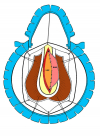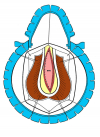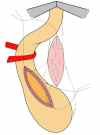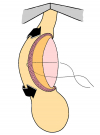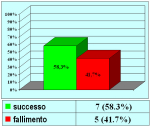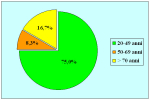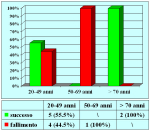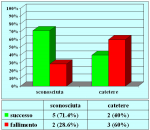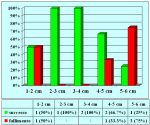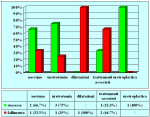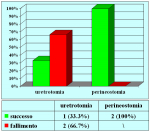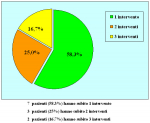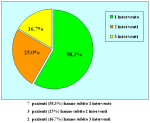L’intervento denominato “uretroplastica con innesto di mucosa orale” consiste nell’aprire completamente l’uretra nel punto in cui è presente la stenosi ed allargare il canale con un innesto di mucosa orale.
|
Figura 1 |
Figura 2 |
Figura 3 |
Figura 4 |
Fondamentalmente, esistono quattro tipi di uretroplastica con innesto di mucosa orale:
- Uretroplastica con innesto ventrale di mucosa orale. In questa procedura, la mucosa orale viene suturata nella faccia ventrale del canale uretrale (figure 1,2).
- Uretroplastica con innesto dorsale di cute o mucosa orale. In questa procedura, la cute o la mucosa orale vengono suturate nella faccia dorsale del canale uretrale (figure 3,4).
- Uretroplastica con innesto laterale di mucosa orale. In questa procedura, la mucosa orale viene suturata nella faccia laterale del canale uretrale.
- Uretroplastica con sostituzione completa di mucosa orale. In questa procedura, la mucosa uretrale viene sostituita completamente con la mucosa orale.
L’intervento chirurgico denominato Uretroplastica con innesto di cute o mucosa orale è indicato fondamentalmente nei pazienti con stenosi, non traumatica, dell’uretra bulbare di lunghezza superiore a 2 cm.
Articolo n° 1
Barbagli G, Palminteri E, Lazzeri M, Guazzoni G.
One-stage circumferential buccal mucosa graft urethroplasty for bulbous stricture repair
Urology. 2003 Feb;61(2):452-5.
Articolo n° 2
Barbagli G., Guazzoni G., Lazzeri M.
One-Stage bulbar urethroplasty: Retrospective analisys of the results in 375 patients
Eur Urol 2008; 53:828-33
Barbagli G, Palminteri E, Lazzeri M, Guazzoni G.
One-stage circumferential buccal mucosa graft urethroplasty for bulbous stricture repair
Urology. 2003 Feb;61(2):452-5.
Articolo n° 2
Barbagli G., Guazzoni G., Lazzeri M.
One-Stage bulbar urethroplasty: Retrospective analisys of the results in 375 patients
Eur Urol 2008; 53:828-33
1. Domanda: L’intervento può essere effettuato in regime di convenzione con il Sistema Sanitario Nazionale?
Risposta: L’intervento chirurgico può essere effettuato in regime di convenzione con il Sistema Sanitario Nazionale, senza alcuna spesa per il paziente.
2. Domanda: Per questo tipo di intervento quale tipo di anestesia è previsto?
Risposta: Anestesia generale con intubazione nasale.
3. Domanda: Quante ore dura l’intervento?
Risposta: Circa due ore
4. Domanda: Ci sono rischi per l’erezione, la fertilità e la continenza urinaria, dopo l’intervento?
Risposta: No
5. Domanda: Quanti sono i giorni di degenza in ospedale previsti per questo intervento?
Risposta: In genere il ricovero ospedaliero varia da 5 a 7 giorni.
6. Domanda: Per quanto tempo dovrò portare il catetere dopo l’intervento?
Risposta: Il catetere deve rimanere in sede per quattro settimane dopo l’intervento. Fino a quando non verrà effettuata la prima radiografia di controllo postoperatoria.
7. Domanda: Quali particolari limitazioni sono suggerite durante la convalescenza?
Risposta: Durante la convalescenza è suggerito l’uso di un antibiotico per via orale fino a che non viene rimosso il catetere. È suggerito di non effettuare lungi viaggi in auto, lavori pesanti, attività sessuale e sportiva.
8. Domanda: Quanto tempo dopo l’intervento potrò riprendere la mia attività lavorativa, sportiva e sessuale?
Risposta: Le attività lavorativa, sportiva e sessuale possono essere riprese gradualmente dopo circa 30 giorni dalla rimozione del catetere.
9. Domanda: Dopo l’intervento posso usare la bicicletta od il motorino?
Risposta: L’uso di bicicletta, motorino, cavallo, mezzi a sella in palestra sono sconsigliati.
10. Domanda: Quali cibi e bevande devo evitare dopo l’intervento?
Risposta: L’uso di birra, vini spumanti e gassati sono controindicati. Un uso esagerato di cioccolata, cacao, frutta secca, crostacei non è consigliato.
Risposta: L’intervento chirurgico può essere effettuato in regime di convenzione con il Sistema Sanitario Nazionale, senza alcuna spesa per il paziente.
2. Domanda: Per questo tipo di intervento quale tipo di anestesia è previsto?
Risposta: Anestesia generale con intubazione nasale.
3. Domanda: Quante ore dura l’intervento?
Risposta: Circa due ore
4. Domanda: Ci sono rischi per l’erezione, la fertilità e la continenza urinaria, dopo l’intervento?
Risposta: No
5. Domanda: Quanti sono i giorni di degenza in ospedale previsti per questo intervento?
Risposta: In genere il ricovero ospedaliero varia da 5 a 7 giorni.
6. Domanda: Per quanto tempo dovrò portare il catetere dopo l’intervento?
Risposta: Il catetere deve rimanere in sede per quattro settimane dopo l’intervento. Fino a quando non verrà effettuata la prima radiografia di controllo postoperatoria.
7. Domanda: Quali particolari limitazioni sono suggerite durante la convalescenza?
Risposta: Durante la convalescenza è suggerito l’uso di un antibiotico per via orale fino a che non viene rimosso il catetere. È suggerito di non effettuare lungi viaggi in auto, lavori pesanti, attività sessuale e sportiva.
8. Domanda: Quanto tempo dopo l’intervento potrò riprendere la mia attività lavorativa, sportiva e sessuale?
Risposta: Le attività lavorativa, sportiva e sessuale possono essere riprese gradualmente dopo circa 30 giorni dalla rimozione del catetere.
9. Domanda: Dopo l’intervento posso usare la bicicletta od il motorino?
Risposta: L’uso di bicicletta, motorino, cavallo, mezzi a sella in palestra sono sconsigliati.
10. Domanda: Quali cibi e bevande devo evitare dopo l’intervento?
Risposta: L’uso di birra, vini spumanti e gassati sono controindicati. Un uso esagerato di cioccolata, cacao, frutta secca, crostacei non è consigliato.
| Risultati aggiornati al 31 dicembre 2013 | |||

Tabella pazienti |

Tabella fallimenti |
||

